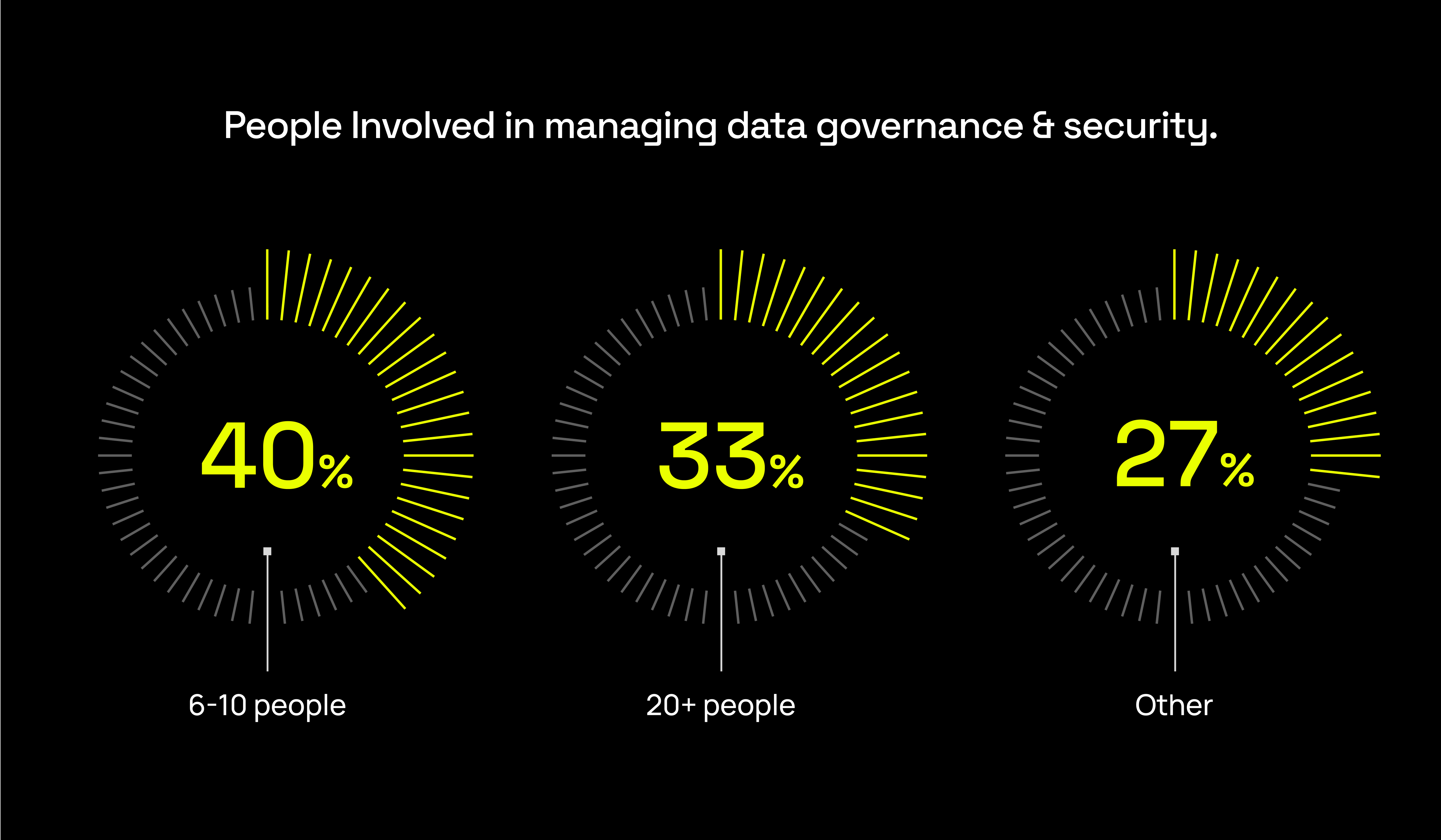We have, for example…around 20 or 30 data stewards that are supporting 500 [or] 600 data practitioners in different levels."
Alessandra De Almeida, Executive Director of Data Management and GovernanceWhen we talk about slow data access, the blame tends to be pinned on two factors: outdated technology and manual data governance processes. The 2025 State of Data Security Report validates that perception: 41% of respondents say that not having the right tools blocks efficient data access and management, while 62% cite data governance as a key contributor to data access delays.
Still, data governance teams are the engine that moves data through organizations. And as they receive a massive influx of data access requests from AI-enabled data consumers and non-human identities (NHIs), their role is rapidly evolving. It’s a shift that’s creating seismic changes for data governors, and could have ripple effects on innovation, compliance, and business performance.
Keeping up with data access provisioning at the speed of AI requires fighting fire with fire — in other words, giving data governance teams the AI-powered tools that will scale their impact without causing headaches, hesitation, or security gaps. I shared my perspective on that vision — and how it inspired Immuta AI — here, and in this blog we’ll look at what else data governance teams should do in order to quickly adapt to the new normal of AI.
Where we’ve been: Data governance in a cloud-first world
Even before large language models (LLMs) and other AI applications started to impact their day-to-day responsibilities, data governance teams have played a major role in moving data throughout the organization. Their scope includes:
- Ensuring the collection, accuracy, classification, and integrity of data in their designated area.
- Collaborating with data consumers to understand data use requirements.
- Implementing and enforcing data governance policies and controls.
- Assessing data access requests and making access decisions.
- Monitoring data quality and addressing issues as they arise.
- Achieving compliance with regulatory and organizational requirements.
- Maintaining governance standards across the organization.
But even these tasks were rife with complexity. The 2025 State of Data Security Report, which surveyed 700+ data professionals, found that 44% think too many people are involved in data management and decision-making, with a third reporting that 20+ people have a hand in governing data. While oversight is often a positive, too much of it often leads to more dependencies, more inconsistencies, and more miscommunications.

It may come as no surprise, then, that 64% of respondents say they face significant challenges providing timely, secure data access to authorized users, and 39% blame complex and unscalable data access policies and processes.
Still, while the cloud increased data governance teams’ scope somewhat, a barrier to entry still existed that helped cap their workload: Users that lacked database access were unable to request access to data. Think of it as security by default. But with AI, that barrier is disappearing — and that has major implications for governance teams.
Where we’re going: Data governance in an AI-powered world
Regardless of role, AI is changing the way we work. And in some cases, it’s leveling the playing field.
In the book Co-Intelligence, author and AI expert Ethan Mollick found that “in study after study, the people who get the biggest boost from AI are those with the lowest initial ability — it turns poor performers into good performers.” In terms of data usage, that means that non-technical users will be better equipped to handle data that was once beyond their domain.
So, what does that mean for data governance teams? The barrier to entry that once existed — and by default, limited the number of data consumers requesting data access — will be a thing of the past (if it isn’t already). It’s not necessarily problematic that more data will be more useful to more people; it is problematic that the population trying to access that data will far exceed the people tasked with managing it — the governance stakeholders.
As AI becomes more ubiquitous, more users — both human and nonhuman identities — will demand fast access to data. But, unless organizations make major investments in human resources, there will still only be a handful of data governance personnel tasked with responding to each and every request.
As Alessandra De Almeida, Executive Director of Data Management and Governance at Merck, said during a fireside chat:
When you add AI into that equation, the 10x difference between governance stakeholders and data users will move closer to 100x. The exponentially increasing burden on data governance personnel will not only increase wait times for data access — which 37% of data professionals already say takes a week or more — but it will increase the risk of unauthorized data exposure and non-compliance as governance teams struggle to balance speed, scale, and security. Already, 55% of survey respondents say that their data security strategy is failing to keep up with the pace of AI.

“The more data you have, the more important it is to secure it,” said Kurt Gardiner, Senior Engineering Manager for Data and Machine Learning at nib Group.
Moving fast means people by default need to have access to the things they need for their day jobs, but balance that with…ensuring that [it’s] well trusted, well audited, well verified."
Kurt Gardiner, Senior Engineering Manager for Data and Machine Learning
A future in which AI outpaces the work of data governance teams doesn’t have to be reality. With tools that are primed to manage AI-driven data consumption, these teams can scale their influence without gaps or compromises.
How to adapt data governance teams for AI scale
The scale, speed, and complexity that AI is adding to data workflows is unprecedented — but not unmanageable. Here’s how data governance teams can adapt to meet the growing scale and demand of AI-powered ecosystems.
Adjust your strategy
Maybe your data governance strategy worked well enough in the “security by default” world. But if you haven’t revisited it since that barrier began to erode, it’s time.
“I think AI is part of everybody’s journey at this point in time,” said Shelly Washington Woodruff, IT Executive at General Motors. “When you start looking at it from a privacy, trust, reliability, and responsibility viewpoint, those are things that we have to incorporate into our overall…data governance strategy.”
In addition to the core elements that GM is integrating, your data governance strategy should:
- Broaden the scope of data consumers to include AI agents and nonhuman identities.
- Incorporate new AI tools that your company has adopted, including those meant to aid in governance processes.
- Account for new and evolving regulations around AI with which you’ll need to comply.
- Establish continuous monitoring of data and AI systems, as well as an incident response plan.
Integrate AI-powered governance tools
As we saw earlier, data governance is often seen as delaying data access. But with AI tools meant to accelerate those processes — like Immuta AI — data governance teams can scale in proportion to their increasing demands.
We don’t want technology to be a bottleneck, but an enabler and an accelerator.... And anything that brings a seamless user experience…is a win-win for all of us.”
Harini Gopalakrishnan, Global CTO of Life Sciences
A few ways in which AI can help data governance teams quickly adapt are:
- Translating plain-language text prompts into robust, dynamic data access policies, so governance teams can federate policy authoring to non-technical users.
- Leveraging metadata, historical patterns, and existing policies to make recommendations about access request decisions, reducing the time needed to manually review each and every request.
- Aggregating user and data metadata to determine whether access should be recertified or revoked, freeing data governance teams from having to constantly manage the recertification process.
- Enabling semantic search, so users can find the data they need without having to use exact search terms to locate it.
Immuta AI is equipping data governance teams with these capabilities so they can easily scale and manage the growing volume of data users and requests that AI is driving. Immuta Copilot is now available in Private Preview — read more about it here.
Federate governance responsibilities
Many organizations are already shifting to a federated model of governance and data management. With AI-powered governance tools, you can also federate responsibilities — namely, policy authoring.
As we mentioned in the previous section, tools like Immuta Copilot make it possible for non-technical governance stakeholders to create access policies simply by typing what they want the policy to do. With no coding experience or additional headcount needed, this allows data governance teams to scale quickly and meet the growing demands of human and agentic data consumers.
Conclusion
Like most functions, AI is reshaping the role of data governance teams and forcing a reimagining of traditional processes. Despite the governance, access control, and AI-related challenges they have been facing, 47% of data professionals anticipate that integrating AI/ML models into business processes will have a high impact on business outcomes. When enabled by AI-powered governance tools and tailored strategies, we can expect that number to rise.
For data governance teams looking for support or guidance as they adapt to the constant shifts that AI introduces, the Immuta team is here for you. Schedule a meeting with our team to be the first to see how Immuta AI capabilities can help you scale at the speed of AI.
Make AI work for you.
Empower data governance teams with the right tools.



